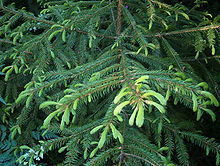Picea koraiensis
| Korean spruce | |
|---|---|

| |
| Young Korean spruce | |
| Scientific classification | |
| Kingdom: | Plantae |
| Clade: | Tracheophytes |
| Clade: | Gymnospermae |
| Division: | Pinophyta |
| Class: | Pinopsida |
| Order: | Pinales |
| Family: | Pinaceae |
| Genus: | Picea |
| Species: | P. koraiensis
|
| Binomial name | |
| Picea koraiensis | |
| Synonyms[2] | |
| |
Picea koraiensis, commonly known as Korean spruce, jong-bi-na-mu (Korean: 종비나무),[3] hong pi yun shan (Chinese: 红皮云杉), or jel koreiskaya (Russian: ель корейская),[4] is a species of spruce native to China, Russia, and North Korea.
It is a medium-sized evergreen tree growing to 30 m tall, and with a trunk diameter of up to 0.8 m. The shoots are orange-brown, glabrous or with scattered pubescence. The leaves are needle-like, 12–22 mm long, rhombic in cross-section, dark bluish-green with conspicuous stomatal lines. The cones are cylindric-conic, 4–8 cm long and 2 cm broad, maturing pale brown 5–7 months after pollination, and have stiff, smoothly rounded scales.
Its population is stable though low, and there are no known protocols that protect it. It is found mostly in the northern Korean Peninsula near the Yalu River, and in Siberia near the Ussuri River. In China it is restricted north-eastern provinces Heilongjiang, Jilin, and Liaoning. It is also believed that it might possibly occur in areas in southern Ussuriland.
It is closely related to Koyama's spruce (Picea koyamae), and treated as synonymous with it by some botanists.
References
[edit]- ^ Thomas, P.; Zhang, D; Katsuki, T.; Rushforth, K. (2013). "Picea koraiensis". IUCN Red List of Threatened Species. 2013: e.T42326A2972747. doi:10.2305/IUCN.UK.2013-1.RLTS.T42326A2972747.en. Retrieved 29 August 2024.
- ^ "Picea koraiensis Nakai". World Flora Online. Retrieved 29 August 2024.
- ^ English Names for Korean Native Plants (PDF). Pocheon: Korea National Arboretum. 2015. p. 572. ISBN 978-89-97450-98-5. Archived from the original (PDF) on 25 May 2017. Retrieved 24 December 2016 – via Korea Forest Service.
- ^ Earle, Christopher J. (ed.). "Picea koraiensis (종비나무) description". The Gymnosperm Database. Retrieved 29 August 2024.

